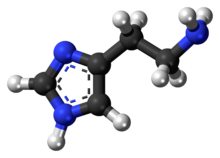| Scombroid food poisoning | |
|---|---|
| Other names | Scombrotoxin fish poisoning, scombroid syndrome,[1] scombroid,[2] histamine fish poisoning,[1] scombroid poisoning[3] |
 | |
| Histamine | |
| Specialty | Emergency medicine |
| Symptoms | Flushed skin, headache, itchiness, blurred vision, abdominal cramps, diarrhea[2] |
| Usual onset | After 10 to 60 min[2] |
| Duration | Up to 2 days[2] |
| Causes | Eat fish high in histamine due to improper processing[2] |
| Risk factors | Tuna, mackerel, mahi mahi, sardine, anchovy, herring, bluefish, amberjack, marlin.[2] |
| Diagnostic method | Typically based on symptoms, blood tryptase[2][1] |
| Differential diagnosis | Allergic reaction,[2] fish allergy[1] |
| Treatment | Antihistamines, epinephrine[2][3] |
| Frequency | Relatively common[2] |
| Deaths | Very rare[3] |
Scombroid food poisoning, also known as simply scombroid, is a foodborne illness that typically results from eating spoiled fish.[2][4] Symptoms may include flushed skin, sweating, headache, itchiness, blurred vision, abdominal cramps and diarrhea.[2][5] Onset of symptoms is typically 10 to 60 minutes after eating and can last for up to two days.[2] Rarely, breathing problems, difficulty swallowing, redness of the mouth, or an irregular heartbeat may occur.[2][5]
Scombroid occurs from eating fish high in histamine due to inappropriate storage or processing.[2] Fish commonly implicated include tuna, mackerel, mahi mahi, escolar, sardine, anchovy, bonito, herring, bluefish, amberjack, and marlin.[2][6] These fish naturally have high levels of histidine, which is converted to histamine when bacterial growth occurs during improper storage.[2] Subsequent cooking, smoking, or freezing does not eliminate the histamine.[2] Diagnosis is typically based on the symptoms and may be supported by a normal blood tryptase.[2][1] If a number of people who eat the same fish develop symptoms, the diagnosis is more likely.[2]
Prevention is by refrigerating or freezing fish right after it is caught.[2] Treatment is generally with antihistamines such as diphenhydramine and ranitidine.[2] Epinephrine may be used for severe symptoms.[3] Along with ciguatera fish poisoning, it is one of the most common type of seafood poisoning.[2] It occurs globally in both temperate and tropical waters.[2] Only one death has been reported.[3] The condition was first described in 1799.[1]
- ^ a b c d e f Ridolo, E; Martignago, I; Senna, G; Ricci, G (October 2016). "Scombroid syndrome: it seems to be fish allergy but... it isn't". Current Opinion in Allergy and Clinical Immunology. 16 (5): 516–21. doi:10.1097/ACI.0000000000000297. PMID 27466827. S2CID 21610715.
- ^ a b c d e f g h i j k l m n o p q r s t u v w x "Food Poisoning from Marine Toxins - Chapter 2 - 2018 Yellow Book". CDC. 2017. Retrieved 1 June 2018.
 This article incorporates text from this source, which is in the public domain.
This article incorporates text from this source, which is in the public domain.
- ^ a b c d e Feng, C; Teuber, S; Gershwin, ME (February 2016). "Histamine (Scombroid) Fish Poisoning: a Comprehensive Review". Clinical Reviews in Allergy & Immunology. 50 (1): 64–9. doi:10.1007/s12016-015-8467-x. PMID 25876709. S2CID 34835091.
- ^ Nutrition, Center for Food Safety and Applied (2022-01-21). "Scombrotoxin Poisoning and Decomposition". FDA.
- ^ a b "Scombroid Fish Poisoning". www.cdph.ca.gov. Retrieved 2023-07-25.
- ^ Nikov, Dim (2023-07-24). "Why Does Tuna Hurt My Stomach?". Home Cook World. Retrieved 2023-07-25.